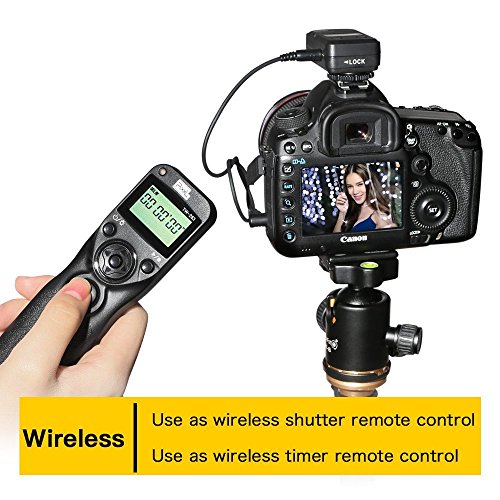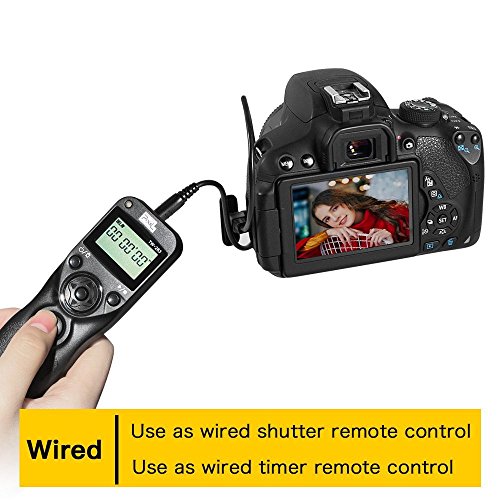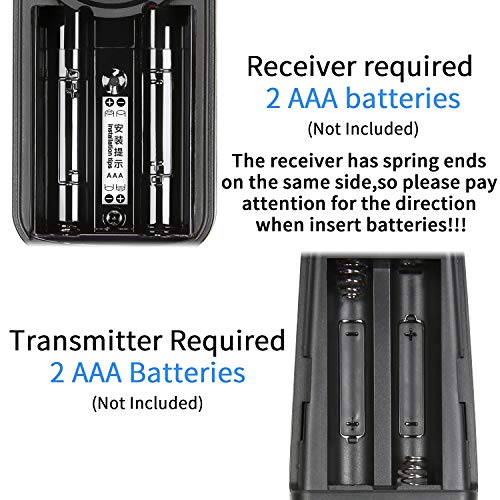- Compatible with Nikon: D3100, D3200, D3300, D5000, D5100, D5200, D5300, D5500, D5600, D90, D7000, D7100, D7200, D600, D610, D750, DF, Nikon 1 V3. Coolpix: P7700, P7800, Coolpix a
- It features no directionality, 80m remote distance and ultra- powerful anti-interference ability. With 30 channels for options, it can avoid interference caused by other similar Devices. Using international 2. 4G transmission technology. It's stable and Quick in response to shutter
- When capturing the beautiful moments of sunrise and sunset and flowers bloom and fade, you don't need to wait for the whole time. You can set delay timer, Exposure time, interval time, number of shoots, repeat shooting interval time and repeat times
- Available to control different brand's cameras and models by changing different camera connecting cable. The transmitter and receiver adopts LCD screen which is more easy and simple to handle
- TW-283 supports simple single shooting, 1sec continuous shooting, [ BULB ] shooting, delay shooting and timer schedule shooting. Delay Shooting Setting can set delay time and shooting number, the delay time alters from 1s to 59s, shooting number alters from 1 to 99. Timer Schedule shooting time can be set from 0 sec to 99hrs59mins59sec. Shooting number can be set from 1 to 99
-
Information
-
Twitter
-
Pinterest
-
Youtube
-
Facebook







Lucky Day
Replaces the "missing" Nikon function... and then some
For those who don't know, Nikon in their infinite wisdom removed an incredibly basic useful feature when they upgraded the D5500 to the D5600 -- they took out the infrared shutter remote capability. Because I do photography for how-to instruction, I need to appear in about 90% of all photos I take. No longer having the remote feature, my work has been compromised tremendously since buying the camera. Sure, you could still set a timer on the camera itself (after clicking through menus) and then race to get into the photo, but the luxury of setting up a shot, getting into it and then being able to take as many shots remotely as you liked was gone -- you had to get out of the shot, reset the camera, and then take another shot every single time. Unfortunately, in all its promotional material for the new D5600, Nikon neglected to mention they removed the single most useful function for how I work. I had no idea. So here I am with my new camera (purchased to replace an older D5300 which was damaged), and no effective way to do what I need to do. I didn't want to get rid of the new D5600 -- in spite of the tone of disappointment you've probably picked up regarding the missing function, the camera is otherwise far superior to its predecessors, and takes crisper, sharper photos than the old ones ever did. Now, Nikon does offer a shutter remote and receiver for the newer cameras -- two separately purchased items for a mere total of around $170 or so (you could get the old infrared remote in a generic version for 9 bucks) -- but not only did I not want to spend that much to replace a feature that used to come standard, but the Nikon remote system has no means of setting a timer. After spending $170, you would still have to go back to the camera after very single shot to reset the timer. Heck with that. So, enough complaining about Nikon. After researching potential solutions I decided on this Pixel Pro TW-283, Nikon version. I am beyond pleased. I now have full remote shutter control again, and a lot more. In addition to merely being a remote shutter control for single shots, you can also set for continuous shooting, BULB shooting, my precious remote/delay shooting, and more. Further, where Nikon give you only a few set timer options (2, 5, 10 & 20 seconds), the TW-283 can be set anywhere from 1 to 59 seconds. It works flawlessly. Set up is a no-brainer: Put in batteries, set the channel if you need to (you probably won't), attach the receiver to the camera hot shoe, plug the somewhat too-long cord into the DC2 port on the left side of the camera, turn everything on and you're good to go. Seriously, that's it. I can't recommend this remote shutter system enough. A few things to be aware of --- With the receiver plugged into the camera, you will no longer be able to move the articulated screen on the D5600 (or any other camera that has the screen hinge on the same side as the ports) -- the cord and plug are in the way. No way around this, as that's where the Nikon accessory ports are located. Unfortunately, I always twisted that screen forward to help compose shots I was in, so I'm gonna need to come up with a workaround for that. Note that this isn't a criticism of the Pixel TW-283 or even the Nikon, really -- those ports have to be somewhere. The construction of the receiver and remote is quite good, but they are by no means heavy-duty. The receiver is safe and sound mounted on the camera, but you'll have the remote in your hand anytime you use it. The remote is on the large side and has a bit of heft to it, and if you drop it on a hard surface (such as the concrete floor of my workshop), it ain't gonna last. In fact, I doubt seriously that it would withstand a single drop to a hard floor, so take care with it. I put mine on a lanyard attached to my belt so I could never drop it to the floor. When taking a shot I click the remote and then let the remote hang from my belt out of sight. If you're a frustrated Nikon D5600 owner, I share your pain. (But otherwise it's still a fantastic camera, ain't it?) This Pixel Pro TW-283 solves the problem of Nikon's (stupid) decision to remove infrared remote capability, and then offer even more features and capabilities.
Keriann Pepper
Works Great!
I needed a remote shutter release with great distance and let me use my L bracket. I found the Pixel remote, so I thought I would give it a try. I have used it multiple times and it works great. I haven't had a problem standing far away and triggering the shutter. I can know use my L bracket in portrait mode which is great. I do have slide the bracket about an inch off center so the cable fits, but it's not a big deal. For the price, it can't be beat. It's easy to use and it allows me to set up my tripod and step away.
Jessie Besson
Once you figure out the manual, this thing is a gem
I have owned three shutter releases in the past. The first one was a cheap wired release that broke after a month of use. Then I had a wireless release that I liked, but was run over by a car. I replaced that with the same brand, but an updated model. That is ok, but isn't the greatest. This is really everything I want. I will quantify it with likes and dislikes. Let's start with the dislikes. 1. The manual is horrible. The layout is atrocious, and the grammar is worse. I actually came up with a cheat sheet (I pasted it below in case it is useful to you!) to replace it. 2. The product pictures led me to believe the cable was hardwired, but it's removable. And it's short. About 18 inches long. 3. There is no wrist strap for the transmitter. Now what I like. 1. It uses AAA batteries in both the transmitter and receiver. And it has really long battery life. 2. The wire can be plugged into the transmitter, which turns it into a wired setup instead of wireless. This could be really handy if you want to pack lighter. 3. The UI for everything except timer mode is straightforward. 4. The LCD screens have backlights, great for night shooting. 5. The delay mode (countdown X seconds and take Y shots) is great for family portraits. 6. The remote distance is really good. The manual claims 80m, which I haven't tried. But I did get about 15m (50ft) away, through 2 walls. Those two wall prevented me from getting any further away. 7. It's reliable. It work every time, except when the remote is too far away. 8. If you need a longer cable, 3.5mm headphone jack extension plugs can be bought cheap. As you can see, the pros far outweigh the minor cons. I cannot recommend this enough. ---------------- Cheat sheet ---------------- --Single Shot-- * Put transmitter in single shot mode * Put camera in single shot mode * Press shutter button on transmitter --Continuous-- * Put transmitter in continuous mode * Put camera in continuous mode * Press and hold shutter button on transmitter --Bulb-- * Put transmitter in bulb mode * Put camera in bulb mode * Press shutter button on transmitter once to start * Press shutter button on transmitter again to end --Delay-- * Put transmitter in delay mode To set * Press center button on transmitter * Adjust number of shots (left) and delay before starting to shoot (right) To shoot “single” shot * Put camera in single shot mode * Press shutter button on transmitter * After countdown, camera will take 1 shot per second until number of shots is reached To shoot “multi” shot * Put camera in high speed continuous shot mode * Press shutter button on transmitter * After countdown, camera will take 2-3 shots per second until number of shots is reached --Timer-- * Put transmitter in timer mode (any of the top modes) * Put camera in single shot mode * Focus and put the lens in manual focus To set * Set the delay to the time before the first shot * Set the long to 0 seconds (this is really only useful for bulb shooting, or to shoot multiple shots in the long interval) * Set the interval to the time between shots * Set the N1 to the number of shots you want to take * Set the repeat to the amount of time you want to wait before doing everything again (think of it as another delay) * Set the N2 to the number of loops you want to happen. Double dash (--) means loop forever To shoot * Press the play/stop button on the transmitter to start * Press that button again to end
Maria Louise
English instructions were simple to understand (comes in Chinese and English) and the remotes themselves are pretty intuitive. May have to start taking some time-laps ...
Was looking for a remote trigger (have wired and IR but needed more distance) to be able to set-up a camera behind a basketball net to take pictures through the glass during high school games. After reading multiple reviews I went with this pixel and it took me all of 5 minutes to get it set-up and focusing/firing multi-shots remotely. English instructions were simple to understand (comes in Chinese and English) and the remotes themselves are pretty intuitive. May have to start taking some time-laps series too to see how well it works. Highly recommended.
Yuuki Cross
Great wireless shutter release
I have used the line-of-sight remotes on my D90 and D810 cameras and have been disappointed with the range and the fact that I must be in direct line-of-sight of them. This one solves those problems and adds a number of additional features. I particularly like the time lapse option that is completely programmable. There are multiple cables available to allow the remote unit to mate with different cameras.
Georgia Papathanasios Siemion
Great For Light-Use
I've used this shutter release remote only for astrophotography. I've had no problems with range. The furtherest I've been away from the camera is about 8-feet, and it still worked. Some people claim it's complicated to use, but I've not found it to be. Frankly, I think it's all pretty much self-explanatory. I think if I were someone who needed to use a remote shutter release a lot, I'd probably have purchased a better-made remote setup. It's very light-weight and is made of cheap plastic. But, overall, it definitely does the job. No complaints...hence the 5 stars.
Summer Day
Very Impressed with this product!
I was very pleasantly surprised by how well this worked, especially for the price. I used it to do some astro-photography in Borrego Springs, CA. I was able to trigger it from pretty far away, at least 50 feet. I was able to get some really cool shots with this. Pros: Great price Works well even at a pretty far distance Consistent, it fired when I needed it to Cons: None that I have found yet.
Rhiru A. Biñas
Very functional, inexpensive, and fun remote
I'm enjoying experimenting with long exposures using this remote. The instructions were a little confusing but not enough to downgrade my rating. As a regular remote shutter release you use the large round button on the remote to release the shutter but with long exposures, you program the remote and then "upload" your program to the receiver connected to the camera using the the button under the display on the right side of the remote with the play/stop icon. With the camera in "bulb" mode, the receiver takes over from there and "plays back" your programmed exposure sequence. Once you get the hang of it, you can program long exposures (up to 99 minutes); well beyond the normal range of most cameras' manual settings. I bought it for the ability to program exposures longer than 30s, but it also works great as a regular remote shutter release button or an intervalometer for shooting a series of time-lapse photos. I can't comment on its range because I haven't tried it very far from my camera. This remote is much more functional that a simple remote shutter release and for what it costs I think it's a bargain. It will give you some new things to try with your photography.
Ne Ha
Best Photography Thing I Have Bought in a While
This thing is a lot nicer than its low price would suggest. It's nicer and more solid feeling than my Neewer wired cable release. I take a lot of long exposures from a tripod using an L bracket, and my old wired cable release was annoying me because I would always have to gaffer tape it to the tripod legs to keep it from swinging around. And also, the cable where it plugs into the socket was pinched by the L bracket. I blamed that on my Sunwayphoto L bracket, but now I realize it was the poorly designed cable release. This one fits like a glove. I figured wireless would just straight be easier. And this is easier to use, more convenient, and as I said, the build feels nicer. I don't use the time lapse and shutter delay features because these are built into my 5Dsr and 7Dii, but they look typical and similar to the ones on my wired cable release. Bulb mode works fine: one push to open the shutter another to close it, with a handy timer that runs while it's open so show you where you are. Very nice! There are a lot of choices out there for wireless shutter releases. I just randomly picked this one and got very lucky. It was a great buy!
Tara Woods
I was not so sure if I wanted a wireless model vs a wired model but after using the wireless release this past week to take some
I had been using a Trigger Trap for some time as a remote release but since they went out of business several months ago I figured it would only be a matter of time before an Android update broke the functionality. A few weeks ago I was standing in a creek shooting a waterfall with my phone dangling above the water and I also felt there had to be a "safer" way. This product seemed to be well rated and worth the investment. I was not so sure if I wanted a wireless model vs a wired model but after using the wireless release this past week to take some low light photos and landscapes with my Canon 80d I was glad I went this route. This is very easy to setup and use. I like to play with things to see how they work and how intuitive they are before reading the manual. I was impressed with the base functions of just a release then after reading the manual happier to see the other functions, an unexpected bonus! As for range, I did not do a scientific test on the range but I set up the camera in the living room of my home and no matter what floor or room I was in the shutter released when pressed. This can also be used as a wired release as well but the cord is very short to do this. The cord is really just meant to plug from the receiver to the camera's remote release port.